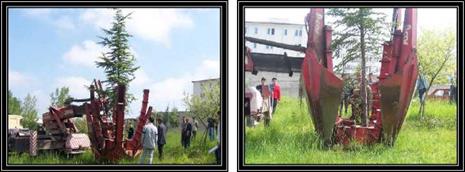Plantation: Plants were planted into the pits where piles were situated according to the project. Trees whose northern sides were marked with oil paint were brought to the planting field and they were placed in a way to face the same direction and stand straight. Pits were irrigated with plenty of water before plantation.
Refilling removal pit after plantation: Pits that were formed during plantation were filled with soil. In this way roots could be ventilated and they were protected from drying and dying. Soil that was used for filling had a pervious structure and was mixed with organic substance.
Protection of Stem: Stems were wrapped with sacks in order to protect newly grown trees from sunburn, frost cracks, damages of winds and cold.
Supporting of root fescue: Newly transplanted trees were supported in order to make them get used to their new places and protect them from environmental pressures. In the supporting works, trees were roped with rubber hoses by leaving 2-3 cm spaces from stems of trees according to the incline of the field. Rubber hoses were roped to trees from 3 sides tightly with 45° angle (Figure 15 and 16).
![]()

|
|
|
|
|
|
|
|
|
|
|

![]()
Fig. 15. Detail of supporting made with buried piles under the ground.
 |
 Fig. 16. Detail of supporting made with vertical piles.
Fig. 16. Detail of supporting made with vertical piles.
Pruning: Branches of trees that were broken and dried were pruned. This had a big effect in preventing water loss. 1/3 – У4 of unnecessary branches were pruned and growth direction was controlled.
Irrigation and Mulching: Mulching with 5-10 cm thick rotten leaves and well developed fertilizer applied on the bottom and all around the plants that were transplanted; mulching process decreased evaporation in the soil around roots thus protected the humid in soil. On the other hand, mulching balanced the heat of soil and made a positive effect on the life of the plant. Plants that were transplanted were irrigated periodically in order to develop the relation between root and soil and give necessary moisture to the soil.
5. Conclusion
Transplantation is the process of removing plants that are at a certain age and planting them to other places in order to create the desired effect. When places such as public gardens, youth centers, schools, Olympiad villages should be designed in a short time, especially trees that are at a certain height and form are preffered. Plantation of young bushes doesn’t create the same effect created by the older ones. The importance of transplantation in terms of landscaping as to minimize the loss of time until small bushes grow and have enough strength in the field. Younger bushes create the desired effect in 20-30 years while planting big trees that have aesthetic, functional and climatic effects will create the desired appearance and will balance size and space in a short time.
Transfer time is very important in the process of removing and transferring plants. The most proper time for transplantation is the stable period between October and March. Mechanic tree mover rented for transplantation was requested from Karabuk Municipality on March. But as the municipality had used the vehicle for its works, it was sent to the project on May. As the weather was very sunny and hot on the day of transplantation and the vehicle was rented only for two days, there was no other choice but to complete transplantation in two days. This caused plants to adapt their new places difficultly. As the proper period for transplantation, namely early spring had passed and it was very hot, a more intensive care was necessary. Not making enough maintenance caused drying of two Cedrus libani species. Dried cedars were removed from the field.




